Reopening NYC: Queens Restaurants + Street Vendors Weigh In
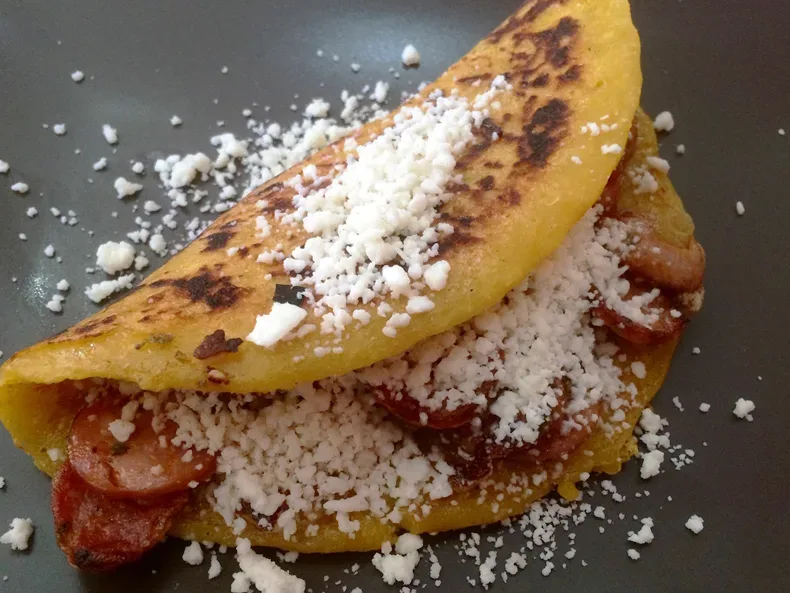
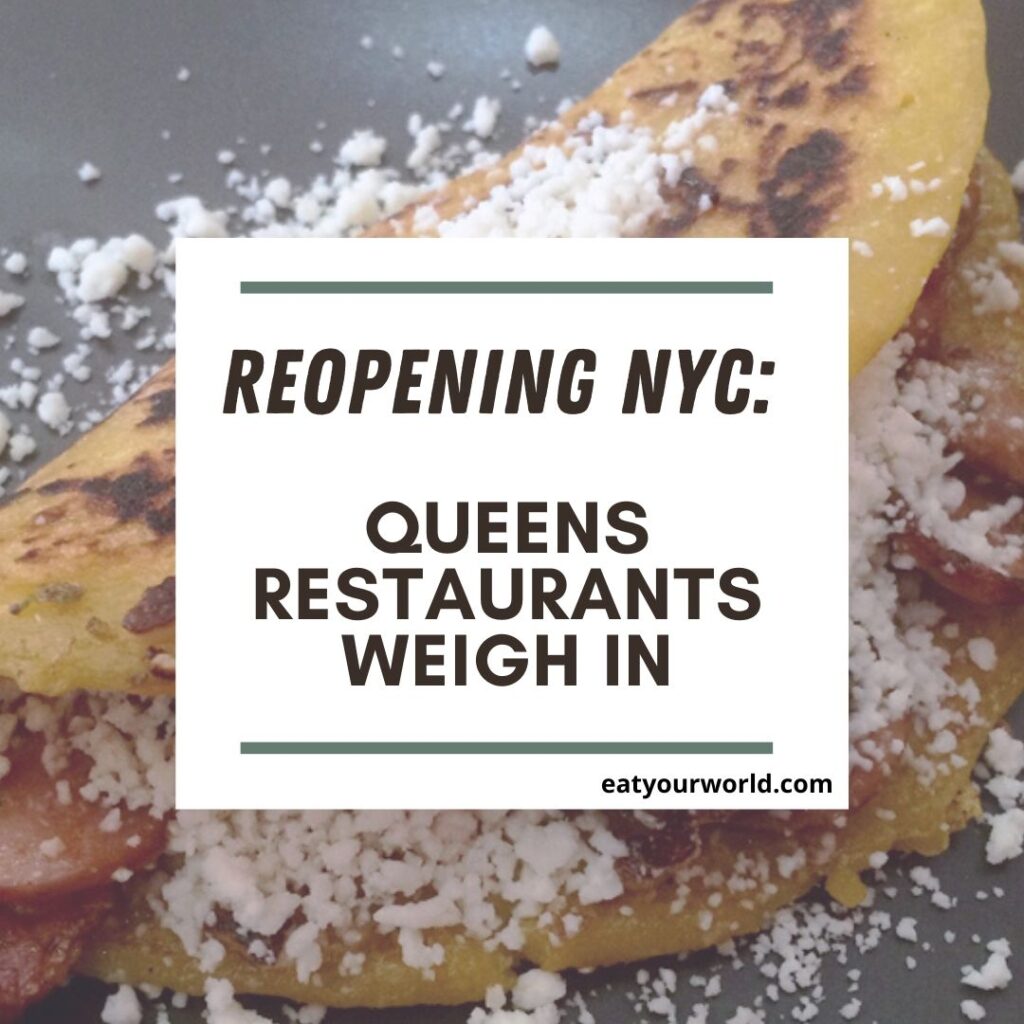
We’ve all heard about the struggles of restaurants, in New York City and elsewhere, but what about the ones we know and love in our own neighborhoods? It’s a question that’s weighed on me, as the few I’ve been in touch with personally in Jackson Heights have expressed many struggles over the course of the pandemic. A lot of the businesses here in our part of Queens are small and immigrant-owned, compounding the difficulty of obtaining financial aid. So in recent weeks I’ve spoken or emailed with a few restaurant and street cart owners in Queens to ask: How has it been for you these past few months, and what does “reopening” look like to you?
Since the time I started these interviews, things have already shifted, with this week’s Phase 2 reopening permitting outdoor dining (among other things). The streets of Jackson Heights have quickly been transformed into sidewalk cafes. It’s all very new and interesting, still scary to some and a literal lifesaver for others.
Below are four interviews, edited for clarity, with the owners of Arepa Lady, Antojitos Doña Fela, The Queensboro, and Nepali Bhanchha Ghar. They’re different sorts of restaurant businesses, but for each one thing remains constant: The future is wildly uncertain. For these and other restaurants you love, wherever you might live, the best thing to do is simply support them—order takeout or delivery, dine in if it’s possible and you’re comfortable with it. And post and share about them afterward, to help spread the word.
In the U.S. it is also worth following and supporting the INDP Restaurant Coalition, which is pushing Congress for billions more in aid to independent restaurants—you can find a form to email your reps about it here—and in New York City, the Street Vendor Project, a nonprofit that works to support nearly 2,000 street vendors in the city.
And now, a little insight into the lives of restaurant owners and street vendors in Jackson Heights, Queens, once the epicenter of the coronavirus outbreak in New York City.
[bctt tweet=”Reopening NYC: Queens Restaurants + Street Vendors Weigh In” username=”eat_your_world”]

Arepa de choclo with chorizo from the Arepa Lady
The Neighborhood Stalwart
The Arepa Lady, 77-17 37th Ave.
[bctt tweet=”“We just hope we can survive this.” —Alejandro Osorio, The Arepa Lady” username=”eat_your_world”]For nearly three decades, since its humble beginnings as a Roosevelt Avenue street cart run by Maria Cano, the Arepa Lady has been a Jackson Heights fixture. When Cano’s sons opened a brick-and-mortar Arepa Lady back in 2014, we were all comforted by the sense of permanence it seemed to bestow on the business: The Arepa Lady was here to stay. Since then it’s been forced to leave one location for another, shut down during the pandemic in the face of piling bills—and suddenly nothing feels permanent anymore. Here’s co-owner Alejandro Osorio on the future of the Arepa Lady.
You were closed for a while and opened up May 1 for takeout and delivery. How did you make that decision?
We stayed open after they put the restriction in place that you couldn’t have anybody sitting after 8pm, at the very beginning. We were open for about two weeks, and it was just really slow. Too slow. So we decided to close about 7 weeks. On May 1 we decided to open up because our rent is still running here. [Our] Brooklyn [location] didn’t charge us rent, but here we are still being charged. It’s just myself and my wife working, and [we have some] guys who alternate. We cut our hours a little bit. Usually we’re open from 11-11 every day, and now we’re opening about 12 to 8, sometimes a little later on the weekends.
How has takeout and delivery been working for you?
It’s OK, we’re surviving. I mean, it’s slow. Really, really, really slow. But we’re OK. We’re healthy, nobody here is getting sick.
Did you receive any government aid?
We got the PPP loan for our Brooklyn location, but it’s closed. It’s sitting there, I haven’t been using it. We got a couple of thousand for the payroll, but [the restaurant is] closed. To be completely honest, we don’t even know how to use it. We also got the SBA [Small Business Administration] loan for both places, but it’s a 30-year loan or something like that. We didn’t apply for the max amount. We’re scared to get into debt.
They give you a grant at first, a couple of thousand, but then the loan itself you have to pay back.
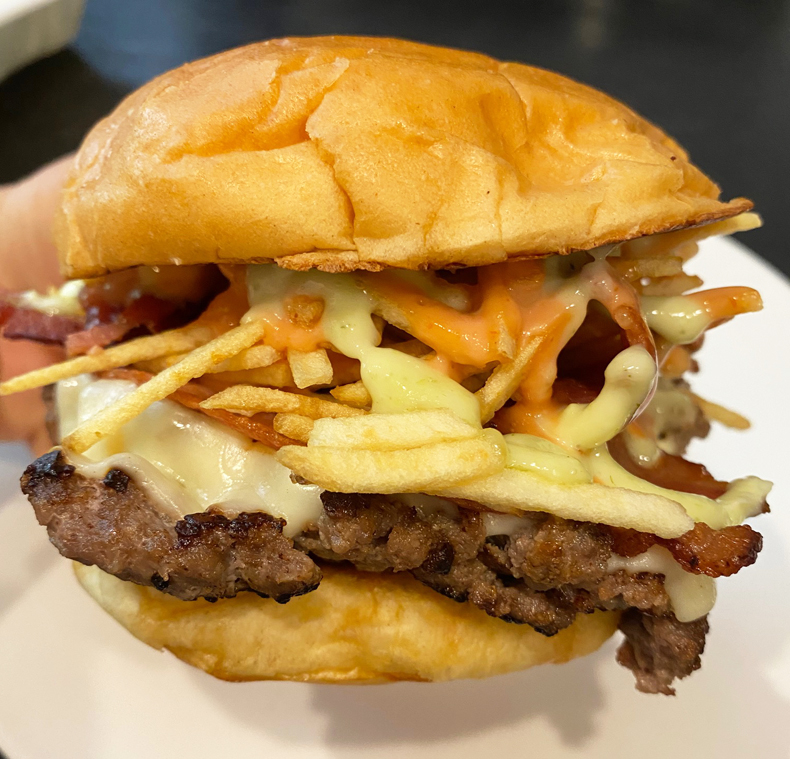
The Arepa Lady’s off-menu Colombian burger
With Phase 2 upon us, will you be able to do any sort of outdoor dining?
We’re talking about that. We’re not sure if that’s safe for us, for our employees, for customers. It’s gonna be hot, you have to wear masks. We’re completely unsure. We have some space for a table or two [outside], but we’re not sure. If you come in just for to-go, we see you for only a few minutes, you go outside and wait for your food. But there’s more contact if you’re sitting there and [we] have to talk to people.
I’ve seen places open up a window and serve out the window, but the crowds can really get bad and we don’t want to do that.
To be completely honest even if they told us we could open up right now to sit people [inside], I don’t think we would do it. It doesn’t seem safe at all. Especially when some people say this, some people say that, and you’re not sure. If it’s just us, just me—fine. But I don’t want to put other people at risk—my staff, customers. We are thinking if we put tables outside we can just have people order inside like takeout, and they can seat themselves. No service.
Eds. note: In the week that’s passed since this interview, the Arepa Lady has set up outdoor seating in the street parking lane in front of its storefront, with full service, and Osorio reports that business has picked up (and also that it was “very easy” to secure the outdoor dining permit, he’s trying to get more people on the block to do it). Credit cards are now accepted too.
It’s almost like you should move to the streets and become a street vendor again!
[Laughs] To be completely honest, if it was easier to work outside we would! But we know all the struggles of working outdoors.What are your top concerns and hopes for the coming months?
We just hope we can survive this. Right now if we can just pay the rent and pay our bills, we’re OK. We can just weather the storm. I was talking to the insurance broker—workers comp and all those things—we’re still paying the same amount of insurance on everything. For our Brooklyn location our workers comp is something like $9,000 a year, and the place has been closed for four months. And we’re still paying. There’s so many little things.
Is takeout and delivery here in Queens enough to cover the rent?
I think so. But just the rent and the bills, and [to pay] the two guys we are bringing in.
Tell me the one thing everything should try at your restaurant.
There’s always the favorites, the arepa de queso, the arepa de choclo. My wife and I were just in here twiddling our thumbs and made a Colombian burger [pictured above]—that’s pretty good. It’s not on the menu yet, but we have it! It has a patty, bacon, ham, cheese, all the sauces, and fries.
View this post on Instagram
The Street Vendor
Antojitos Doña Fela, 90th St. & Roosevelt Ave.
[bctt tweet=”“We hope Jackson Heights is able to have its hustle + bustle back.”—Stephanie Sucasaca, Antojitos Doña Fela” username=”eat_your_world”]This family-owned Peruvian food cart is, in the words of one of the owners, “a four-woman dream”: grandma (the Doña Fela in question), mother, aunt, daughter. Stephanie Sucasaca is the latter, and reports they’ve been active throughout the pandemic, quickly adapting to changing conditions with the help of the Street Vendor Project (and zero government aid). The weekends-only cart is also the source of my kids’ favorite quarantine meals—if you haven’t yet tried the food from here, now is a great time to do so! Here’s more from Sucasaca on life as a Jackson Heights street vendor during Covid-19.
You’ve been one of the few street vendors to stay open for most of the pandemic, and you’ve even helped provide meals to healthcare workers. Can you tell us how those efforts took shape, and what prompted you to open up so early?
We quarantined for two weeks once the city went into PAUSE, and because we are essential workers we were able to get back out. We communicated through the pandemic with Street Vendor Project; they provided a lot of support on how to vend in the best way following the ever-changing protocols. We decided to open up after the two weeks [of quarantine], after we made sure nothing was happening in our home (for us it was a risk because my grandmother has asthma and is higher-risk). It would have been great to be able to quarantine during PAUSE, but we couldn’t because bills were still coming and the nature of the business is to go out. It was a tough decision to make, but we really were grateful to Street Vendor Project for providing guidance.
We were connected through the SVP to a GoFundMe account started by a registered nurse [Cynthia Kang was one of the organizers] at Elmhurst Hospital to provide meals for Elmhurst workers. It was a community effort out of the beautiful charity and support that we saw the community come together and pull together funds to support each other.
How has the takeout/delivery model worked for you, and what adaptations have you made?
Pre-Covid-19, Monday through Friday we were at the Peruvian consulate and Sat-Sun we’d be at the food cart in JH. After the pandemic the Peruvian consulate closed down so we stopped going there. We took the time to work on production with tamales because we were running low, so we caught up a little during the two-week break and focused on our social media marketing. We started to use more digital marketing tools [like Instagram] out of this, and of course started delivery to deliver food to folks who didn’t want to go outside, to help make things a little safer. I think people in quarantine have gotten tired of cooking and want to order food. That’s where the delivery piece has really helped.
We expanded the lunch menu during Covid-19 because we didn’t feel safe grilling right away and wanted to still provide lunches. Also, we [started doing] prepackaged lunches for people to pick up, to make it safer and quicker..
Our new schedule is Fridays, Saturdays, and Sundays. Fridays is delivery only, and you can also pick up from our house [in East Elmhurst]. Weekends we set up the lunch at the food cart (from 1-5pm), and we are out there from 6:30am with breakfast. Folks come to pick up their tamales early!
Now street traffic is a little more normal, since Phase 1 of reopening started a few weeks ago, so there’s been more foot traffic. Also some of the protests that have happened helped with people buying food because they’ve been marching around the neighborhood.
What measures are you taking to keep staff and customers safe?
We changed the setup of the food cart to enable social distancing, using a table and cones to create a space of separation. We put up a lot of placards with information explaining social distancing, and have sanitizer at the front for folks coming in so they can use it if they want, during the exchange of bags and money. The sauces were moved so they’re outside the cart now, and people can grab them themselves.
Another adaptation we made is going cashless. We had Venmo and Cash App before, but we’ve been using that more now, of course. As mentioned we started doing prepackaged lunches so it’s easier and quicker to take out and go. We wear gloves and masks, and disinfect every time before we start and leave the cart, with water mixed with Clorox.
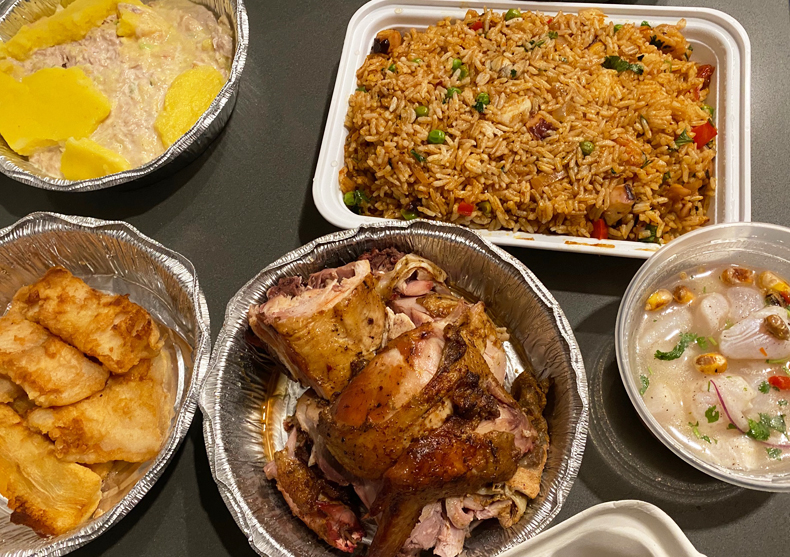
Clockwise from top left: causa de atún, arroz con mariscos, ceviche de pescado, pollo al cilindro, chicharron de pescado. (Anticuchos, grilled beef hearts, are just out of view!)
Did you receive any government aid?
No, we didn’t receive any aid from the government. Street Vendor Project has been helping to connect people to those different types of grants, but we haven’t been eligible for any. We’ve been focused on just working and trying to build it up that way. It really did help to have that GoFundMe, that really supported us. Because that was at the beginning of the pandemic, when foot traffic was really low and deliveries were just starting. People didn’t know then that we were vending anymore.
What does official “reopening” look like for you? Will much change for you as a street vendor?
Reopening has no date for us street vendors, as essential workers. We have been working throughout the pandemic.
I just anticipate more foot traffic. The summer is a big month for street food, that’s when people are out, so those are the highest months. We used to set up for folks to dine at the cart [using a little bench] but we’re not setting up for that yet, until we see how things go. We’re just going to have takeout at the cart. We want to see how the reopening goes for the rest of the industry.
What are some of your top concerns and hopes for the next few months?
We definitely hope there’s not a second wave of cases and a resurgence of this. We’re really hoping on a macro scale that we’re able to move forward globally, and in NYC, from the pandemic. That’s the first big hope.
We hope to continue to grow with our business plan, and to also help support our fellow street vendors with adapting to this, so as our neighbors have come back we’ve given them the tips that we’ve learned. We’re all doing the best that we can. We hope Jackson Heights is able to have its hustle and bustle back, and that we’re all safe as well.
Moving forward, I know the mayor announced the policing of street vendors would no longer be done by the NYPD, and I think that’s great, but we want more clarity on that because we don’t necessarily know whose jurisdiction that would fall into. That’s a political question we have.
We’re excited to see all our [vending] neighbors come back. It’s just hard to maintain not coming back out, when mortgages, rents, weren’t canceled—they were only frozen, so those bills are still pending, along with all the other bills that come every month. It’s been challenging in that sense. A lot of folks are struggling still, trying to figure out how to eat enough. But we learn from each other, definitely.
What’s the one thing everyone should try at your stand?
Everything is so good, but everyone needs to try anticuchos. They’re the most savory, surprising meat—it is grilled [beef] heart, but it’s so delicious, and so tender. Don’t knock it till you try it! And the picarones [sweet potato doughnuts]. They’re delicious vegan homemade goodness. They’re fried fresh, which is why they’re so amazing. Crunchy on the outside, fluffy on the inside. And they go so well with the anticuchos; it’s just a perfect balance. Eat them after—some people like the sweet and savory combo, but I personally like my anticuchos first and then my picarones.
Picarones are fried fresh, and that’s why they’re so amazing. They end early—by about 2pm normally; for holidays they may be done by 11am-12pm. You can call us during the week if you want to just pick some up.
And the tamales—that’s how we started. For folks coming for breakfast, that’s what you want to try, along with the salsa criolla, a pickled onion sauce that goes with it. There’s a Peruvian saying all our Peruvian customers say: “Tamal sin cebolla no es tamal.”
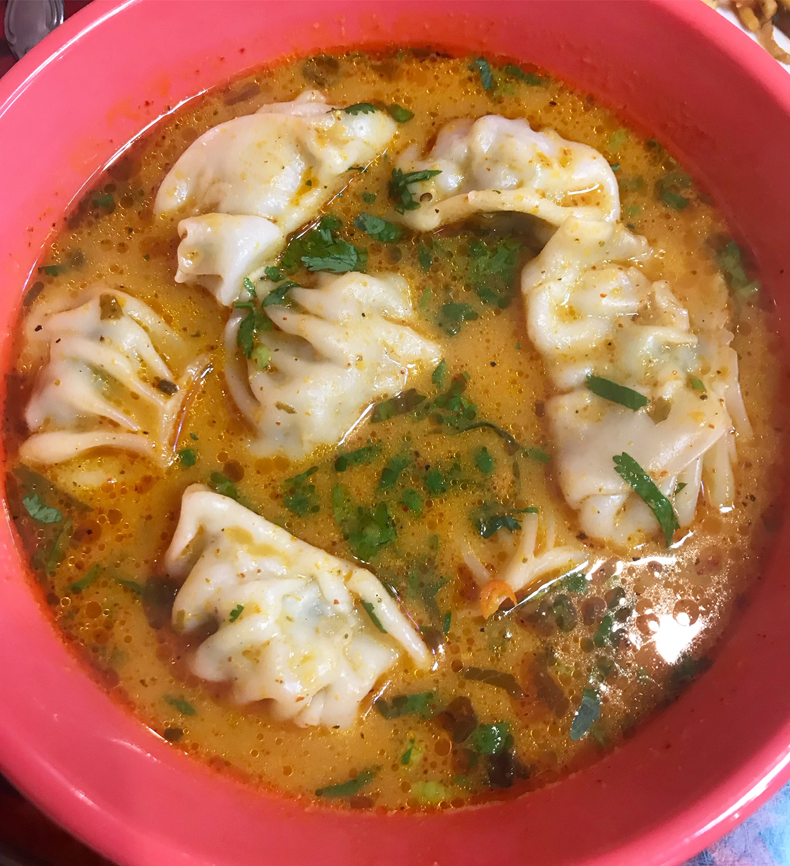
Nepali Bhanchha Ghar’s award-winning jhol momo, dumplings in spicy broth
The Momo Queen
Nepali Bhanchha Ghar, 74-15 Roosevelt Ave.
[bctt tweet=”“The situation is very critical for a small business like me.”—Bimla Shrestha, Nepali Bhanchha Ghar” username=”eat_your_world”]Nepali Bhanchha Ghar is the little restaurant that could. Since opening the original 37th Rd. branch of her Nepali eatery in 2015, owner Yamuna “Bimla” Shrestha been featured in The New York Times, has won the Momo Crawl championship belt three years running, and more recently has relocated to a bigger location around the corner on Roosevelt Avenue. It’s a spot this writer personally loves and has long included on food tours for adults and kids alike in Jackson Heights. Like many in the Himalayan community, Shrestha closed for a few weeks early in the pandemic, simply because business completely dried up. She told me at the time she had “no idea how to get access to relief funds.” Things have since improved, but Nepali Bhanchha Ghar’s future remains on shaky ground.
During the first few weeks of the pandemic, you were mostly closed, though you slowly started to sell momos and other menu items. Why did you stay closed for so long?
As a matter of fact, I tried to stay open for takeout even in between pandemic, but it did not go well. Sales were almost null, so I closed for a long time.
How has takeout been working for you since you came back?
In the beginning, the takeout model was going bad, now it is [picking up] pace a bit more.
Did you end up applying for and receiving any government aid, and was it enough?
I did apply, and I got the least amount of funding from the federal PPP program. The funding was not enough, and I am now facing huge financial hardships ahead in order to carry on my restaurant. I even tried some private loans in order to pay my rent, but during this pandemic, the loan companies did not provide any sorts of loan, so I am hoping the state or federal government will provide a loan or grant. Otherwise the situation is very critical for a small business like me.
When the government allows, do you plan to reopen Nepali Bhancha Ghar for dining? And could you do outdoor dining?
If I am allowed to open, yes, I will do that. Yes to sidewalk seating too.
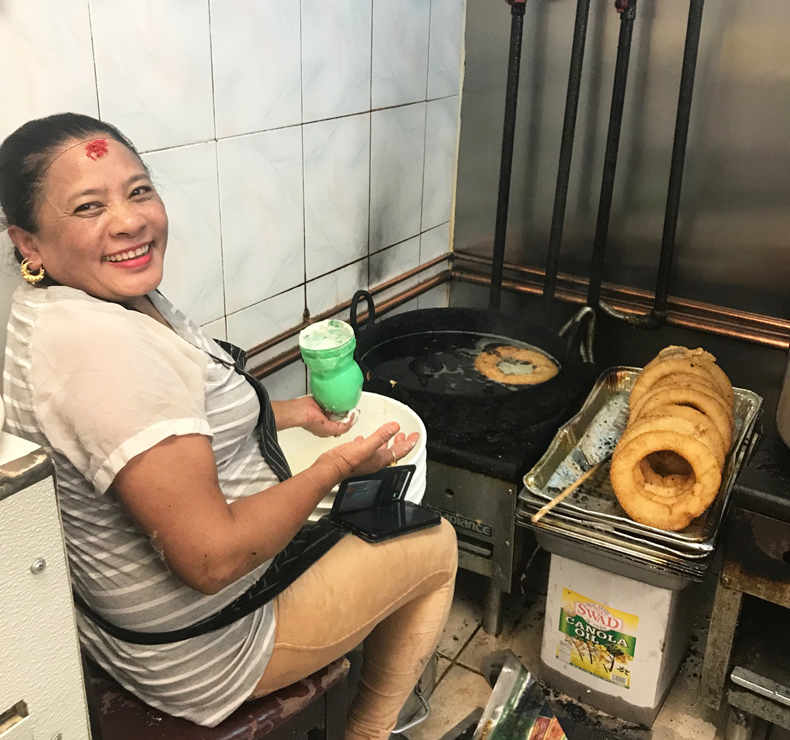
Yamuna “Bimla” Shrestha in easier times.
What measures are you taking to keep staff and customers safe?
Staff and customers’ safety is always our first priority. In order to keep them safe, we are using face masks, gloves and sanitizations, hand washing, intensifying cleaning, and encouraging social distancing, among other things.
What are some of your top concerns and hopes for the next few months?
I have a huge challenge ahead, the first and foremost [being] economic hardship. The amount I received from the federal government is not enough at all. I have to pay restaurant rent for a couple of months—I’m not yet able to pay it by now.
What’s the one thing everyone should try at your restaurant?
If I just choose one thing that everyone should try at my restaurant, it will definitely be momo. People across the states come to my restaurant just to try momo. I have met people coming from such places as California, Boston, and Texas in my restaurant to have typical Nepali food like in Nepal. [Other great dishes are] sel roti and Nepali, so I invite people to at least try how the typical Nepali food is.
View this post on Instagram
The Gastropub
The Queensboro, 80-02 Northern Blvd.
[bctt tweet=”“A huge concern for us is whether people will still dine out as much as they used to.”—Dudley Stewart, The Queensboro” username=”eat_your_world”]When it opened in 2018, The Queensboro was the restaurant Jackson Heights had been missing—a welcoming neighborhood bar and restaurant serving up local beers, great cocktails, contemporary American food, and plenty of space for the community to use for events (I’ve personally been there for everything from kids’ story hours to improv shows and even a writing workshop). Owned by three Queens guys, it’s a local spot through and through, and it hasn’t stopped serving the community through this pandemic: As the situation grew more dire here in Jackson Heights and Elmhurst, a grassroots relief effort sprung up to fill the gaps in aid, with the “Q” at the center of it, working with a number of organizations to help provide meals and groceries to healthcare workers and neighbors in need. Co-owner Dudley Stewart filled us in on how this came to be, and what’s up next.
The Queensboro became a central artery of the grassroots relief effort during the pandemic, and at the same time you increasingly offered more of a menu and service to customers via takeout and delivery. Can you tell me how those efforts took shape?
We put a stop to indoor dining a little while before the mayor’s office ordered all restaurants and bars to close because we didn’t want to put our staff and customers at risk. Over the next couple of weeks we began to offer drinks to go while we worked out how to adjust our business model for those strange times. We began offering “care packages”—boxes of groceries and staples that people could pick up at the restaurant in order to help them avoid going to the stores, and also because a lot of items (such as flour) were really hard to find for a while.
We began to work with Queens Together to help provide meals for essential workers, and shortly after that we also started offering some food for pickup and delivery. This was on a limited basis since we were implementing very strict social distancing rules in the kitchen and could only bring in one or two of our employees at a time. While out doing deliveries we began to notice the lines of people waiting to get prepared meals and groceries from the various food banks operating in our neighborhood, and we decided we needed to refocus our efforts to support the initiatives that addressed this situation. People were going hungry, we’re a restaurant, we should be helping to feed them. That’s when we began to work with the Covid Care Neighborhood Network and World Central Kitchen, and at the same time Queens Together also started to switch from focusing only on the essential workers, so we were all aligned. That worked really well for all of us.
We’ve been able to distribute thousands of meals, and we’re proud that we’ve also helped put together hundreds of bags of groceries for our food-insecure neighbors.
With regards to what we were selling, we gradually began to increase what we offered every day for pickup and takeout, making sure that we did it as safely as possible, and now we’re able to provide a wide variety of food and drinks almost every day.
How has the takeout/delivery model worked for you?
We immediately dropped our partnerships with GrubHub and Caviar—the fees they charged would make it unsustainable to keep offering delivery, so we switched to doing it ourselves, which had the added benefit of letting us bring back more of our employees. It’s not as frictionless as before, but the benefits certainly outweigh the drawbacks and it’s unlikely we’ll return to using one of those services even when things go back to normal.
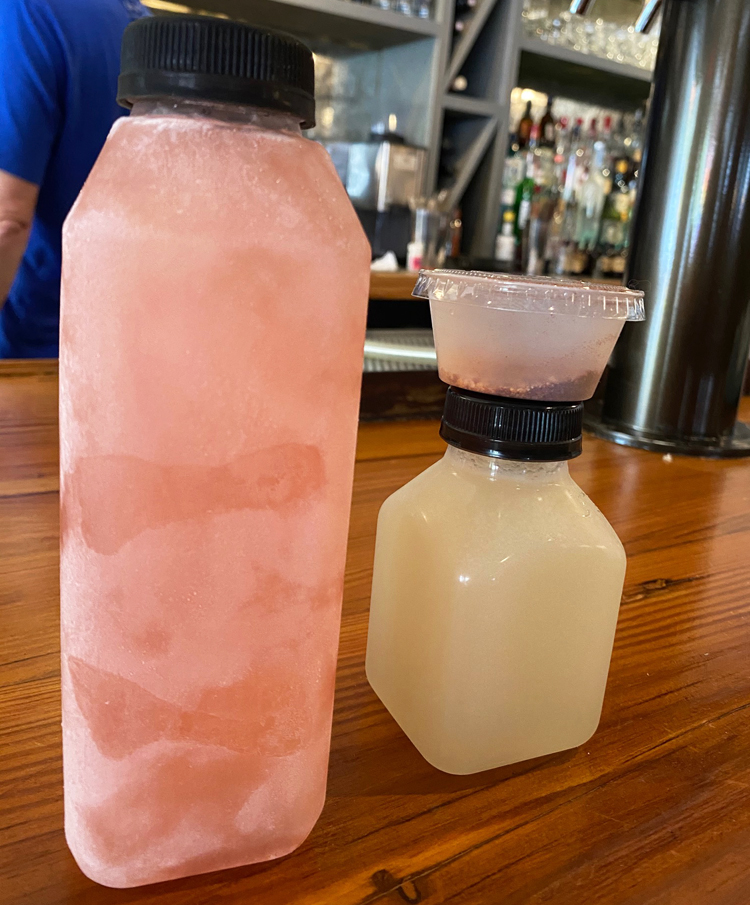
Frosé and a mezcal margarita to go from The Queensboro.
Did you receive government aid, and was it enough?
We made an effort to be on top of any and all aid packages the government was putting together, so we put in our applications early for the various loans and grants that were available. While the structure of some of them (such as the PPP) was initially very inflexible and didn’t suit our business model and current situation, we went for it anyway in the hope that they would adjust it over time, and luckily that’s what happened.
We’re still not where we need to be in terms of the help we’re receiving, but it’s moving in the right direction. What we need are less loans and more programs that address the unique issues that the independent restaurant industry faces, and hopefully all of the advocacy by various industry groups will achieve this.
What are some of your top concerns and hopes for the next few months?
A huge concern for us is whether people will still dine out as much as they used to. The combination of financial insecurity coupled with the obvious health concerns could really damage our regular business. We’re looking into ways of ensuring that we’ll be able to continue operating under those circumstances, with more of a focus on takeout and delivery than we had before, as well as restructuring how we staff and run the restaurant. There could be some substantial changes that would result in us not being able to employ as many people as before, but if the alternative is to close down and not employ anyone we’ll do whatever it takes to stay up and running.
Summer is also a slow period for most restaurants so we have that to consider as well. We’re ready to adapt to the changing situation as we’ve been doing since we first signed the lease.
What’s the one thing everyone should try at your restaurant?
According to some of our customers, our fried chicken is perhaps the best fried chicken on the entire planet. We don’t think we should be making any claims like that, but we can’t stop them from saying it!
Eds. note: Our interview with Dudley got cut a little short before we broached the topic of outdoor dining and safety measures, but suffice to say the Queensboro has been very busy this past week of Phase 2 reopening. The restaurant now has plenty of space for sidewalk dining (currently no reservations are accepted), and a new menu-less ordering system where you can scan a QR code on your table and order/pay for everything via your mobile device. The bar opens at 3pm; food service runs 5pm-9pm. You can still pick up food from 5pm onward, and deliveries are available between 5pm-6pm.
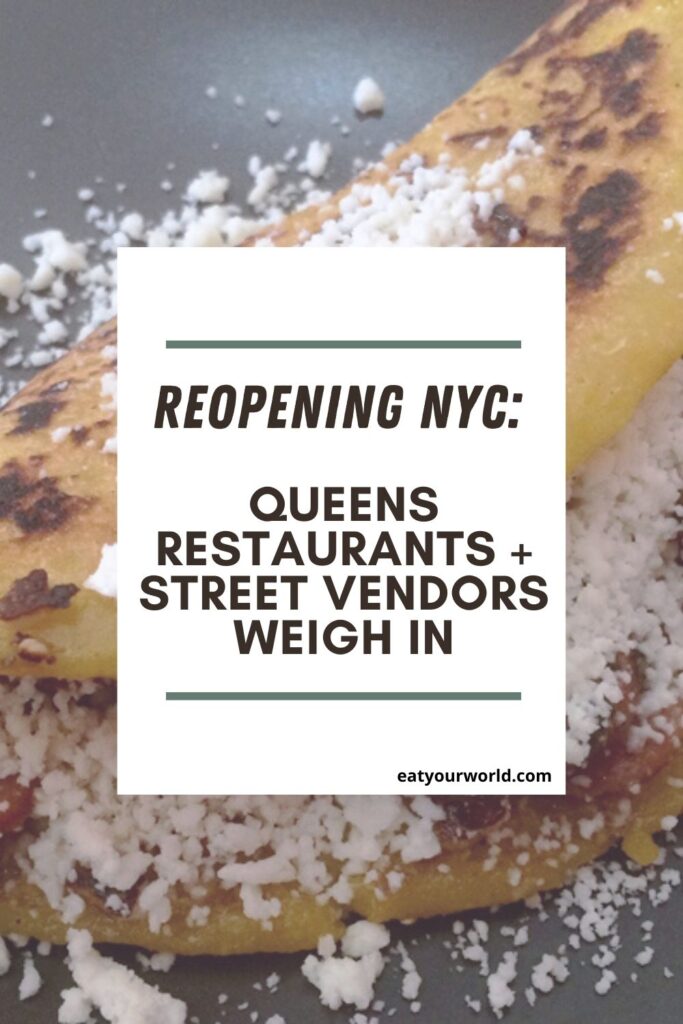
PIN to save for later!



[…] to. It’s become our weekend ritual: I take a break from cooking to order in (and support various local restaurants that really need the business), and we are briefly transported via great food from another […]
nice post. Thanks for making people aware about the reopening of nyc queens restaurants.
Thank you for reading!